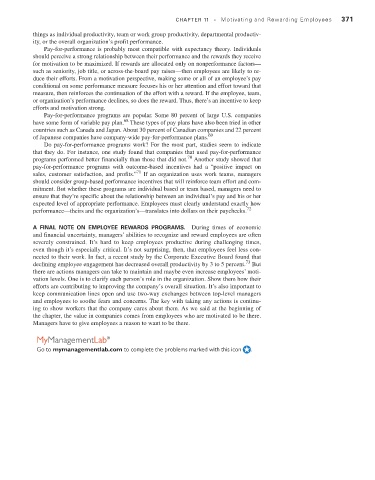Page 372 - Fundamentals of Management Myths Debunked (2017)_Flat
P. 372
CHAPTER 11 • Motivating and Rewarding Employees 371
things as individual productivity, team or work group productivity, departmental productiv-
ity, or the overall organization’s profit performance.
Pay-for-performance is probably most compatible with expectancy theory. Individuals
should perceive a strong relationship between their performance and the rewards they receive
for motivation to be maximized. If rewards are allocated only on nonperformance factors—
such as seniority, job title, or across-the-board pay raises—then employees are likely to re-
duce their efforts. From a motivation perspective, making some or all of an employee’s pay
conditional on some performance measure focuses his or her attention and effort toward that
measure, then reinforces the continuation of the effort with a reward. If the employee, team,
or organization’s performance declines, so does the reward. Thus, there’s an incentive to keep
efforts and motivation strong.
Pay-for-performance programs are popular. Some 80 percent of large U.S. companies
68
have some form of variable pay plan. These types of pay plans have also been tried in other
countries such as Canada and Japan. About 30 percent of Canadian companies and 22 percent
of Japanese companies have company-wide pay-for-performance plans. 69
Do pay-for-performance programs work? For the most part, studies seem to indicate
that they do. For instance, one study found that companies that used pay-for-performance
70
programs performed better financially than those that did not. Another study showed that
pay-for-performance programs with outcome-based incentives had a “positive impact on
71
sales, customer satisfaction, and profits.” If an organization uses work teams, managers
should consider group-based performance incentives that will reinforce team effort and com-
mitment. But whether these programs are individual based or team based, managers need to
ensure that they’re specific about the relationship between an individual’s pay and his or her
expected level of appropriate performance. Employees must clearly understand exactly how
performance—theirs and the organization’s—translates into dollars on their paychecks. 72
a final note on eMPloyee reWarDs PrograMs. During times of economic
and financial uncertainty, managers’ abilities to recognize and reward employees are often
severely constrained. It’s hard to keep employees productive during challenging times,
even though it’s especially critical. It’s not surprising, then, that employees feel less con-
nected to their work. In fact, a recent study by the Corporate Executive Board found that
73
declining employee engagement has decreased overall productivity by 3 to 5 percent. But
there are actions managers can take to maintain and maybe even increase employees’ moti-
vation levels. One is to clarify each person’s role in the organization. Show them how their
efforts are contributing to improving the company’s overall situation. It’s also important to
keep communication lines open and use two-way exchanges between top-level managers
and employees to soothe fears and concerns. The key with taking any actions is continu-
ing to show workers that the company cares about them. As we said at the beginning of
the chapter, the value in companies comes from employees who are motivated to be there.
Managers have to give employees a reason to want to be there.
MyManagementLab ®
Go to mymanagementlab.com to complete the problems marked with this icon .

